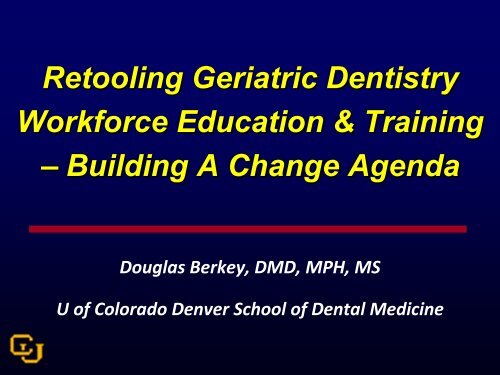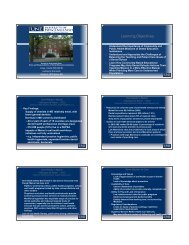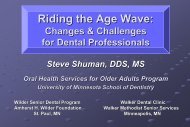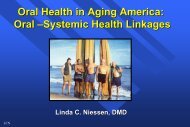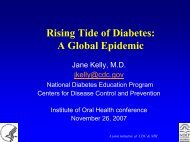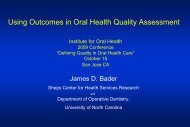Conference PPT (16 MB) - Institute for Oral Health
Conference PPT (16 MB) - Institute for Oral Health
Conference PPT (16 MB) - Institute for Oral Health
Create successful ePaper yourself
Turn your PDF publications into a flip-book with our unique Google optimized e-Paper software.
Retooling Geriatric DentistryWork<strong>for</strong>ce Education & Training– Building A Change AgendaDouglas Berkey, DMD, MPH, MSU of Colorado Denver School of Dental Medicine
To Dr. Ron Inge and IOH --- THANK YOU!This conferenceand it’s outcomestruly representimportant stepsin “advancing theball” with thislooming healthcare crisis.
GeriatricDentalWork<strong>for</strong>ceEducation &TrainingAre we measuring up?
Education and Work<strong>for</strong>ce Issues• Future-of-dentistry reports haveaffirmed that the dental work<strong>for</strong>ce is notadequately prepared to meet the currentand future health needs of older adults.
Education and Work<strong>for</strong>ce Issues• In dental schools, clinical careexperiences focus on the “younger andhealthier” elderly• Students and residents (?) are notgenerally prepared to identify, prioritize,and treat the oral health needs of the“older old”, the frail and functionallydependent elderly.
Rating of Time Devoted toGeriatric Dentistry Instruction25%Percentage20%15%10%5%0%1996 1997 2004 2005ADEASurveys ofDentalSchoolSeniorsInadequateExcessive3 rd or 4 th out of ~20 topics in 96/97; 5 th out of 24 topics in 04/05
ADEA 2005 Senior Survey“Less than prepared <strong>for</strong> practice”Geriatrics (10 th out of 25)DisabledImplantsOrthodonticsPractice Mgt0% 20% 40% 60% 80%
Education and Work<strong>for</strong>ce Issues• Future-of-dentistry reports haveaffirmed that the dental work<strong>for</strong>ce is notadequately prepared to meet the currentand future health needs of older adults.• Due to the paucity of <strong>for</strong>mal training ingeriatric dentistry, we have a “loomingcrisis!”
Work<strong>for</strong>ce ProjectionsAt least 6,000 dental practitioners with“substantial training” in geriatric dentistry bythe year 2000 and 10,000 clinicians by theyear 2020.About 1,500 geriatric dental academicianswould be needed by the year 2000 andabout 2,000 needed by the year 2020.“Personnel <strong>for</strong> <strong>Health</strong> Needs of the Elderly Through Year 2020.” 1987 DHHS Report
Projection assumptions:1) 40% of older adults fall into special needspatient group (50% utilization)2) Dentists with advanced training will serveabout 1,000 independent older adults (50%utilization) in addition to caring <strong>for</strong> functionallydependent pts“Personnel <strong>for</strong> <strong>Health</strong> Needs of the Elderly Through Year 2020.” 1987 DHHS Report
Postdoc Geriatric Dentistry Trainees• Up to 1995, ~100 dentists had receivedpostdoctoral training• During the next decade, another ~100dentists were trained• So ~200 vs projected 7,000 needed by2005 (
Postdoc Geriatric Dentistry Trainees• 2006 federal budget removed allfunding support <strong>for</strong> postdoctoralinterdisciplinary training in geriatricdentistry (Title VII PHSA)(New 3 yr funding cycle 2007 <strong>for</strong> 10 Programs)• Majority of “trained dentists” retiring inthe next 10 years• Stage set <strong>for</strong> “brain drain” of geriatricdentist mentors2006 ADA Report of the Task Force on Elder Care
Geriatric Medicine Parallels• <strong>16</strong>,000 graduate each year• Only 2% seek careers in geriatrics• Less than half report receiving anytraining in geriatricsThe Alliance <strong>for</strong> Aging Research
Geriatric Medicine Parallels• Estimated need <strong>for</strong> 36,000 geriatricians by2030• In 2005, there were only 6,615 certifiedspecialists (1 per 2,500 aged 75+ years)• By 2030 there will likely be only one per3,600 aged 75+ yearsThe Alliance <strong>for</strong> Aging Research
Geriatric Medicine Parallels• "Geriatrics is a lost cause. There are justtoo few [geriatricians] now, and no signthat there is any growing interest" amongmedical students.• "My guess is we'll push things to theprecipice, panic, and then come up with adraconian solution and pump a lot ofmoney into something that we could havesolved much more cheaply years earlier."Dr. Robert L. Kane, Director of the University of Minnesota's Center on Aging
Meeting the oral health careneeds of our older adults“Looming crisis”“Tsunami”“Perfect Storm”“Brain drain”“Lost cause”
Retooling GeriatricDental Education
Building a Change AgendaPredoctoral Geriatric Education/Training• Develop, implement, and evaluate clinicalcompetencies & education standards• Dental school accreditation standards willrequire geriatrics education• Establish core competencies in national boardsand regional licensure board examinations• Employ CQI to improve dental education anddental careBureau of <strong>Health</strong> Professions, 1995
Comparison of Geriatric Competencies“Accrediting bodies and geriatric competency sourcedocuments were easily identified <strong>for</strong> nursing andpharmacology.Senior academic faculty in dentistry and social workidentified the most relevant competency sourcedocuments, because neither discipline’s professionalassociation had approved or adopted competencies ingeriatrics …Mezey M, et al: JAGS 56:1724-1729
Florida expert panel of general dentistsfellowship or mastership from the Academy ofGeneral Dentistrypracticed dentistry at least 3 days a weekdental practices in 1 of 25 pre-selected countieswith greater than 20% of population 65+50 DDS respondents (68% participation rate; x = 52yrs)Dolan and Lauer, 2001
Study Findings“No topic clearly stands out as essential to apredoctoral curriculum. Rather, competency ingeriatrics requires a broad range of knowledge andskills across dental disciplines.Nearly two-thirds of the topics are procedure-based.Dolan and Lauer, 2001
FL Study – Geriatric DentistryCompetency Characteristics45 topics – important areas ingeriatric dentistry that shouldbe included in a predoctoraldental curriculum37 identified as a “top five”topic suggesting competencyrequires knowledge and skillsfrom a broad array of topicsDolan and Lauer, 2001
Building a Change AgendaPredoctoral Geriatric Education/Training• Develop, implement, and evaluate clinicalcompetencies & education standards• Dental school accreditation standards willrequire geriatrics educationSome success … but will it be en<strong>for</strong>ced?Bureau of <strong>Health</strong> Professions, 1995
Commission on Dental AccreditationIn 2006 – CODA accepted greaterresponsibility to assess proficiency in theadoption of new “special needs patient”standards“Graduates must be competent in assessing thetreatment needs of patients with special needs(who are) … those patients with medical,physical, psychological, or social situations thatmake it necessary to modify normal dentalroutines …”
Building a Change AgendaPredoctoral Geriatric Education/Training• Develop, implement, and evaluate clinicalcompetencies & education standards• Dental school accreditation standards willrequire geriatrics education• Establish core competencies in national boardsand regional licensure board examinationsNothing substantial has been doneBureau of <strong>Health</strong> Professions, 1995
Building a Change AgendaPredoctoral Geriatric Education/Training• Develop, implement, and evaluate clinicalcompetencies & education standards• Dental school accreditation standards willrequire geriatrics education• Establish core competencies in national boardsand regional licensure board examinations• Employ CQI to improve dental education anddental care. More studied ef<strong>for</strong>ts are needed!Bureau of <strong>Health</strong> Professions, 1995
Thoughts on Teaching Improvement1. Effective teaching is “burdensome”2. Must teach knowledge, skills, behaviors, and beliefs3. Basic principle of education …. Less is more4. Yet … amount of knowledge to be learned is beyondcapabilities of any individual5. Must teach students to access evidence baseddentistry --- must learn what is valid (Cochrane Database)6. Need to determine which teaching methods work best“Lectures, at best, create enthusiasm but rarely impactknowledge.”Aging Successfully, Vol XV, No. 1
Thoughts on Teaching Improvement7. Individualizelearning; maximizepositive interactivelearning iterations
Pathways to competency in a given task<strong>for</strong> different learnersClinical CompetencySkill level attainedLearner #1Learner #2Learner #3Number of learning iterationsAdapted from Brown & Herbranson, 2007
Pathways to competency<strong>for</strong> different learning tasksClinical CompetencySkill level attainedCD relinesRestoration of root cariesTreatment planningNumber of learning iterationsAdapted from Brown & Herbranson, 2007
Building a Change AgendaPostdoctoral Geriatric Education/Training• Increase the number of postdoctoral geriatricdentistry training programs• Increase the number of postdoctoral academictraining opportunities <strong>for</strong> dental faculty• Postdoctoral general dentistry training programsmust offer advanced geriatric training• Increase alternative pathways to encourage lifelong learningBureau of <strong>Health</strong> Professions, 1995
Building a Change AgendaPostdoctoral Geriatric Education/Training• Increase the number of postdoctoral geriatricdentistry training programsNot yet … but the ADA wants to:“ … develop a plan in 2007 to expandopportunities <strong>for</strong> advanced general dentistryprograms in general dentistry or those with anemphasis in geriatrics that will commence withinthree years.”ADA Task Force Report on Elder Care, 2006Bureau of <strong>Health</strong> Professions, 1995
Building a Change AgendaPostdoctoral Geriatric Education/Training• Increase the number of postdoctoral geriatricdentistry training programs• Increase the number of postdoctoralacademic training opportunities <strong>for</strong> dentalfacultyNothing much yet! HRSA has recentlyrestarted several postdoc fellowshipprograms …Bureau of <strong>Health</strong> Professions, 1995
Can we travel a similar path as pediatricdentistry <strong>for</strong> training new faculty ?
Pediatric Dentistry Work<strong>for</strong>ce Shortage• The American Academy of Pediatric Dentistry(AAPD) first addressed the general pediatricdentistry work<strong>for</strong>ce shortage in the early 1990s• The focus was primarily on the provider basewhich was predicted to be inadequate to addresspediatric oral health problems• This ef<strong>for</strong>t’s success can be seen in over 100new residency positions nationally but this is atwo-edged sword because the demand <strong>for</strong>educators has grownP. Casamassimo, 2008
The Master Clinician• An experienced current or retiredpractitioner who becomes a full orpart time dental school or residencyfaculty member and brings thebenefit of his or her knowledge to anew generation of dentistsP. Casamassimo, 2008
Financing of Master Clinician Program• The AAPD and the Dr. Jerome B. MillerFund of <strong>Health</strong>y Smiles <strong>Health</strong>y Children:The Foundation of the American Academyof Pediatric Dentistry offered scholarshipsto four members to attend the MasterClinician Program.• The Academy <strong>for</strong> Academic Leadershipprovided a fifth scholarship
Master Clinician Scholarship ProgramMore of a “shorter-term fix” ---“Until we in dental education can figure out howto pay young people to come into education, thisis a stopgap. We have a baby-boomer boomer timewindow of about 20 years with the MC program,then we'll have to face the music when no oneenters dental education except from othercountries. Call me a red neck, but them's thefacts and I'm sticking by them.”Paul Casamassimo, 2008
Where will tomorrow’s s geriatricdentistry mentors come from?• Improve opportunities <strong>for</strong> enhancedgraduate degree, fellowship, anddiplomate opportunitiesThe University of Minnesota MS Degree- <strong>Oral</strong> <strong>Health</strong> Services <strong>for</strong> Older Adultshas been the only constant graduateresource (1983-present)
Where will tomorrow’s s geriatricdentistry mentors come from?• Improve opportunities <strong>for</strong> enhancedgraduate degree, fellowship, anddiplomate opportunities• Weigh benefits of creating specialtystatus <strong>for</strong> geriatric dentistry/specialneeds dentistry
Specialty Considerations“Given the rapidly changing population demographics,it may be advisable to study the merger of GPR,hospital dentistry, and geriatric dentistry programs intoa specialty of geriatric/special care dentistry.”2001 ADA Future of Dentistry Report“… investigating the need <strong>for</strong> a non-specialty interestarea in general dentistry <strong>for</strong> geriatric dentistry.”2006 ADA Elder Care Task Force Report
Are we short on knowledge?Only 5 of 404 (~1%)JADA continuingeducation creditarticles had geriatricdentistry as maintheme during past 8years
Gero/Pedo PubMed Citations2002-20072007
Special Needs Specialty Status• United Kingdom• Australia• New Zealand• Brazil
PubMed Journal Citations1998-2007
Building a Change AgendaPostdoctoral Geriatric Education/Training• Increase the number of postdoctoral geriatricdentistry training programs• Increase the number of postdoctoral academictraining opportunities <strong>for</strong> dental faculty• Postdoctoral general dentistry training programsmust offer advanced geriatric trainingIt is happening to moderate degreeBureau of <strong>Health</strong> Professions, 1995
Postdoc Geriatric Dentistry FindingsUS CODA Postdoctoral Dental Directors:GPR, AEGD, Endo, OS, Perio, & Pros(directors with email addresses)AEGD (84) + GPR (187)271 surveys e-mailed9 surveysundeliverable115 surveyscompleted42% responseBerkey & Berg, 2008
How competent are your residency grads inclinical care of patients 75+?Treating coronal caries<strong>Oral</strong> surgeryAssess/dxTreating root cariesMinimally invasive dentistryPercentage answering “Very Competent”Tx planningRPDComplete dentures0 10 20 30 40 50Disease preventionBerkey & Berg, 2008
How competent are your residency grads inmanagement of patients 75+ ?Percentage answering “Very Competent”0 10 20 30 40 50In<strong>for</strong>med consentMedical team communicationHistory takingManaging pts in hospital settingUnderstanding oral implications ofsystemic diseaseTreatment planningBerkey & Berg, 2008
How competent are your residency grads inclinical care of patients 75+ ?Percentage answering “Less Competent Than I’d I d Like”0 10 20 30 40 50Implants (std)Implants (mini)PeriodonticsEndodonticsMinimallyinvasive dentistryBerkey & Berg, 2008
How competent are your residency grads inmanagement of patients 75+ ?Percentage answering “Less Competent Than I’d I d Like”Berkey & Berg, 2008
Pathways to competency<strong>for</strong> different learning tasksSkill level attainedClinicalCompetencyCompletionpredoctoraltrainingTask ATask BTask CCompletion postdoctoraltraining and/orlifelong learningNumber of learning iterationsAdapted from Brown & Herbranson, 2007
Building a Change AgendaPostdoctoral Geriatric Education/Training• Increase the number of postdoctoral geriatricdentistry training programs• Increase the number of postdoctoral academictraining opportunities <strong>for</strong> dental faculty• Postdoctoral general dentistry training programsmust offer advanced geriatric training• Increase alternative pathways to encourage lifelong learning … Moving <strong>for</strong>ward!Bureau of <strong>Health</strong> Professions, 1995
Number of advanced dental educationprograms and instruction methods usedOff-campus didacticOff-campus clinic/labAudio coursesTelecoursesCD-ROMVirtual simulationPBLCBLService learningOSCE0 100 200 300 4002005-2006 ADA Survey of Advanced Dental Education
Educational Materials
Web based learning resourceshttp://www.geriatricoralhealth.org/index.htm
Web based learning resourceswww..com
ADA Educational Strategies“Develop a plan to create a Web-basedclearinghouse of community-basedoutreach programs, practice resources,continuing education opportunities andconsensus reports related to providingoral health care to vulnerable elders.”2006 ADA Task Force on Elder Care Report
Looking beyondDDS training• Exploring Dental Work<strong>for</strong>ce Needs toSupport Elders’ <strong>Oral</strong> <strong>Health</strong> Care“Appropriate agencies of the ADA will investigatenew dental work<strong>for</strong>ce roles specifically <strong>for</strong> thegeriatric population including appropriate functions<strong>for</strong> dental assistants and dental hygienists tosupport care <strong>for</strong> the vulnerable elderly population.”2006 ADA Elder Care Task Force Report
Important Stakeholders“Develop a plan to create a Web-basedclearinghouse of community-basedoutreach programs, practice resources,continuing education opportunities andconsensus reports related to providingoral health care to vulnerable elders.”2006 ADA Task Force on Elder Care Report
Ask Marilyn® (Parade, March 2, 2008)“In your opinion, what is thebest barometer of acountry’s s morality?”Marilyn vos Savant is listed in the Guinness World RecordsHall of Fame <strong>for</strong> “Highest IQ”
Ask Marilyn® (PARADE, March 2, 2008)“In your opinion, what is the bestbarometer of a country’s morality?”The esteem in whichsociety holds its elderly
Retooling GeriatricDental EducationImportant stakeholders must beenlisted to promote an enhancegerodontic work<strong>for</strong>ce/health outcomesADA, ADHA, ADEA, SCD, AADR/IADR, AARP,foundations, governmental bodies (Congress,Bureau of <strong>Health</strong> Professions, NIDCR, CDC,NIA), 3 rd party payers, dental industry, publichealth and aging advocacy groups, etc.
Geriatric Dentistry demandsfrom the practitioner the best ofclinical, psychological, andsocial skills. It ... requires anintegrated approach andadvocacy <strong>for</strong> those who aremost at need. It is imperativethat “we” are trained effectivelyto assume this role!
Geriatric Dentistry Training:A Colorado Story
Senior dental studentcomment last Friday“Today was amazing. I wasable to deliver a partialdenture on one patient, fill agiant Class V on #31 --- thepatient had Alzheimer’s andhad asked me 3-4 times whyshe was here and what Iwas doing to her. And ofcourse, it was great to tell an80 yr old man that he had all28 teeth and no decay …and this was on top of all theunique personalities.”
Program of All-inclusiveCare <strong>for</strong> the Elderly•Community Based•Capitated•Managed Care•Serving Frail Elderly
PACE Programs Nationally
The PACE ExperienceIntegrated, Team Managed CareNursingHomeHomeCareHospitalPrimaryCareTEAMLab / X-rayMedications /DMESpecialists/ DentalDay <strong>Health</strong>NursingSocial serviceOT / PTSpeechNutritionRecreationPersonal carePharmacyTransportation
A rich setting to teach• Interdisciplinary tx planning andclinical care considerations• A philosophy of care – honoringour seniors
What to treat When to treat How to treat Where to treat Whom to treat
Clinical Decision Making / Rational CareBerkey DB, Berg RG, Ettinger RL, Mersel A, Mann J: The Old-Old Dental Patient: The Challenge ofClinical Decision-Making. Journal of the American Dental Association 127:321-332, March, 1996.
Nutritional Problems ?
Can patient give in<strong>for</strong>med consent <strong>for</strong>extractions & self administer pain meds?
Aides in Determining Cognitive StatusMMSE
Diagnosis & Treatment Collaborations
Respecting andhonoring ourseniors!
Working with theTEAM in thedelivery of care
GeriatricDentistryInterdisciplinary treatmentplanning & managementcrucial <strong>for</strong> best outcomes!
Social Worker and DDS Communications
Principles of Family Involvement
Treating cognitive impaired patients
Restraint Guidelines
Do no harm!
“Creative” restorativedentistry andprosthodontics
Extensive Use of Glass Ionomers
Bonded vs Pin-retained ComplexAmalgams
Final Impression Approaches
Prevention Focus
Fluoride to reduce caries risk
CAPE Standardized PatientProgram at CU
Standardized PatientProgram1. Clinical skills testedincluding interviewing,communication, physicalexamination, clinicalreasoning, lab interpretation,diagnostic testinterpretation, & writeup.2. Video taping during patientencounters where you talkthrough all the skills you areper<strong>for</strong>ming
Standardized PatientProgram•Opportunity to work with a variety ofroutine,difficult and sensitive clinicalsituations.•Faculty, peers and the standardizedpatient can offer immediate feedbackabout the students' per<strong>for</strong>mance.•Allows students and faculty to developindividualized learning plans based onthe students' per<strong>for</strong>mance.
Thank You
Questions?
Looking beyond predoctoral training• One year of general practice residency(also AEGD) training needed to preparedentists to treat the frail elderly (~1500residents in 2006)• Two-year program is needed to preparea small group of dentists who would“…<strong>for</strong>m a cadre of teachers of geriatricdentistry on how to treat frail andfunctionally dependent elderly patients.” **Ettinger and Beck; 1984
Musings of a frustrated dental educator“If there were one thing that I think is critical … it wouldbe hands on care supervised … by people withexpertise… it isn’t difficult to understand why dentistsare reluctant to provide care to special needs … <strong>for</strong>some it is just outright fear based on lack of experience… the model (at my dental school) is that if anythinglooks the least bit out of the ordinary (elderly patientswith complex medical histories, etc) they will bereferred …
Musings of a frustrated dental educator“… YIKES! So the supervising faculty members aren’tcom<strong>for</strong>table, they convey this lack of com<strong>for</strong>t to thestudents who in turn learn nothing …except refer themout. So, any and all ways that can help dentists getcom<strong>for</strong>table and experienced in caring <strong>for</strong> specialneeds patients will help. To me that means(proficiently) supervised clinical experience. “


